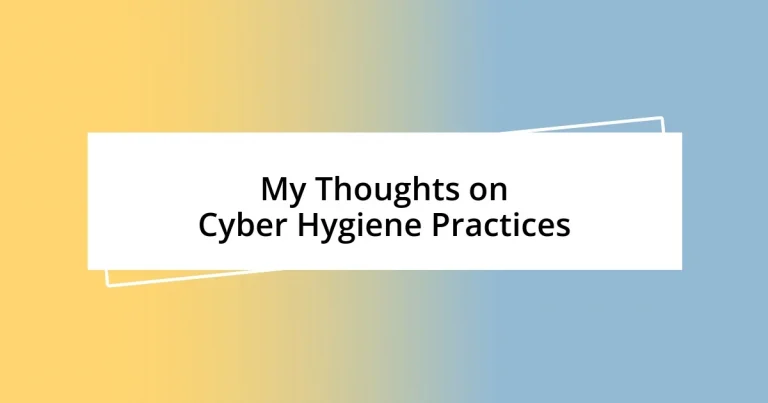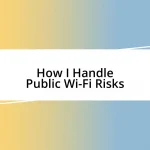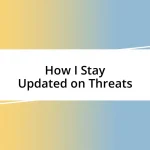Key takeaways:
- Cyber hygiene involves consistent practices, such as updating passwords and enabling two-factor authentication, to protect personal and organizational information online.
- Regularly backing up data and educating oneself about cyber threats, like phishing and ransomware, are essential steps in maintaining robust cyber safety.
- The use of tools like password managers and multi-factor authentication significantly enhances security and reduces vulnerability to cyber attacks.
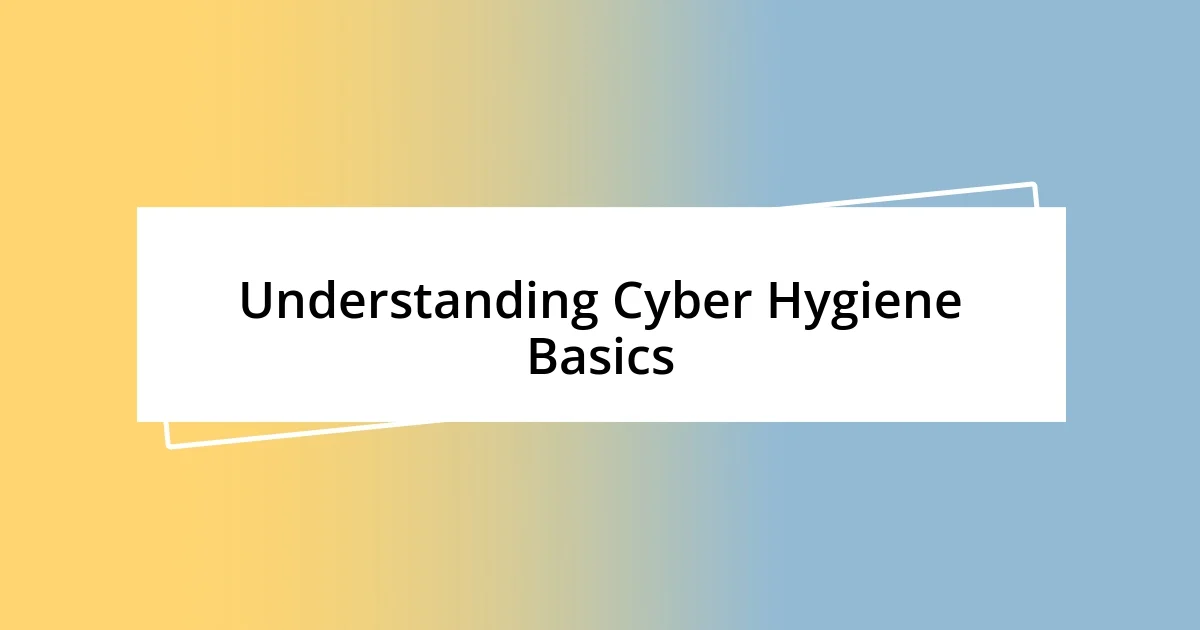
Understanding Cyber Hygiene Basics
Cyber hygiene, at its core, refers to the practices that help protect your personal and organizational information online. Think of it as the digital equivalent of washing your hands; it’s a routine you don’t overlook because the consequences can be serious. Have you ever thought about how often we overlook basic security steps, like updating our passwords or managing software updates?
One experience that stands out to me was when I neglected to change a password for months, believing it was secure. When the service I used was breached, I felt a wave of anxiety wash over me. Realizing that my lack of diligence could have led to a significant breach of my personal data shook me. This kind of situation highlights how basic cyber hygiene practices—such as regularly updating passwords and enabling two-factor authentication—aren’t just technical tasks; they’re essential habits for protecting your life.
In my journey of understanding cyber hygiene, I’ve discovered that being mindful of what information we share online is equally crucial. Reflecting on my own social media habits, I used to share a lot without considering the implications. Have you ever stopped to think what your online footprint looks like? By treating our personal data with respect and awareness, we build a defense against potential security threats—no matter how small they may seem.
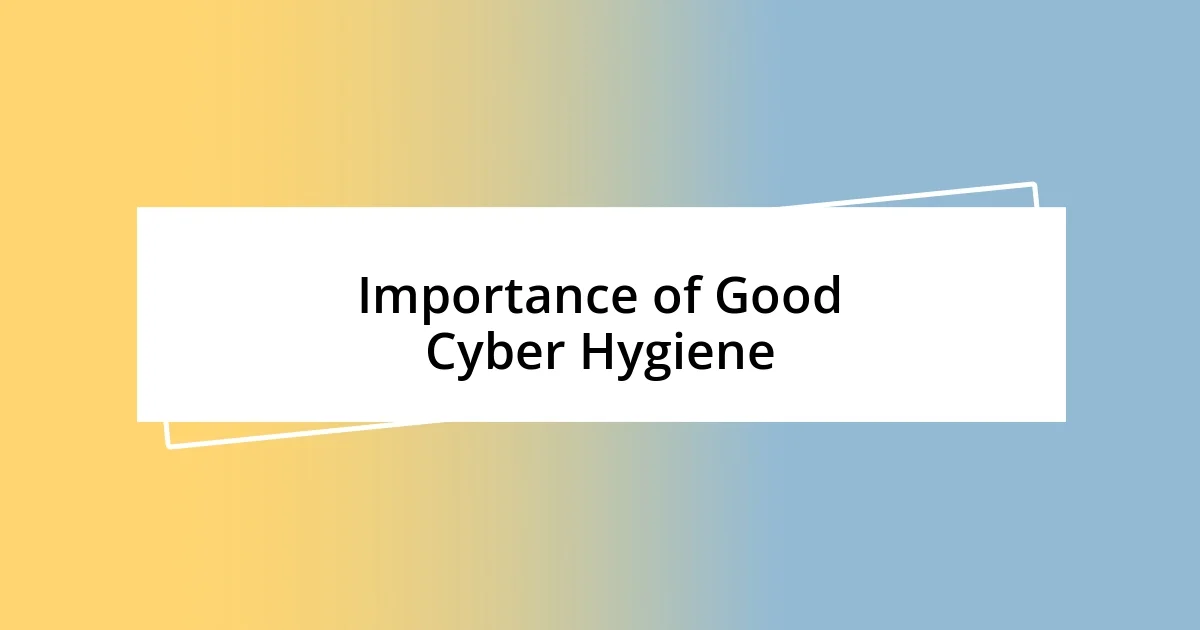
Importance of Good Cyber Hygiene
Good cyber hygiene is crucial because it not only protects our own personal information, but also safeguards the digital environment we all share. I’ve seen first-hand how a single weak link can expose entire systems to vulnerabilities. A friend of mine once accidentally clicked on a phishing link in an email, leading to a massive intrusion on their company’s data. The stress and chaos that ensued were overwhelming, and it made me realize that complacency can have heavy consequences.
To help highlight the importance of good cyber hygiene, consider these practices:
- Regularly update passwords: Change them at least every three to six months.
- Enable two-factor authentication: This adds an extra layer of security, making it harder for intruders to gain access.
- Keep software updated: Ensure that all your devices have the latest security patches to minimize vulnerabilities.
- Educate yourself and others: Knowing about the latest threats can make a significant difference in prevention.
- Limit sharing personal information: Being cautious about what you disclose online helps protect your privacy.
Each of these measures might seem small, but they collectively form a strong defense against potential threats. Having experienced a near-breach myself, I make it a point to stay vigilant and encourage those around me to do the same.
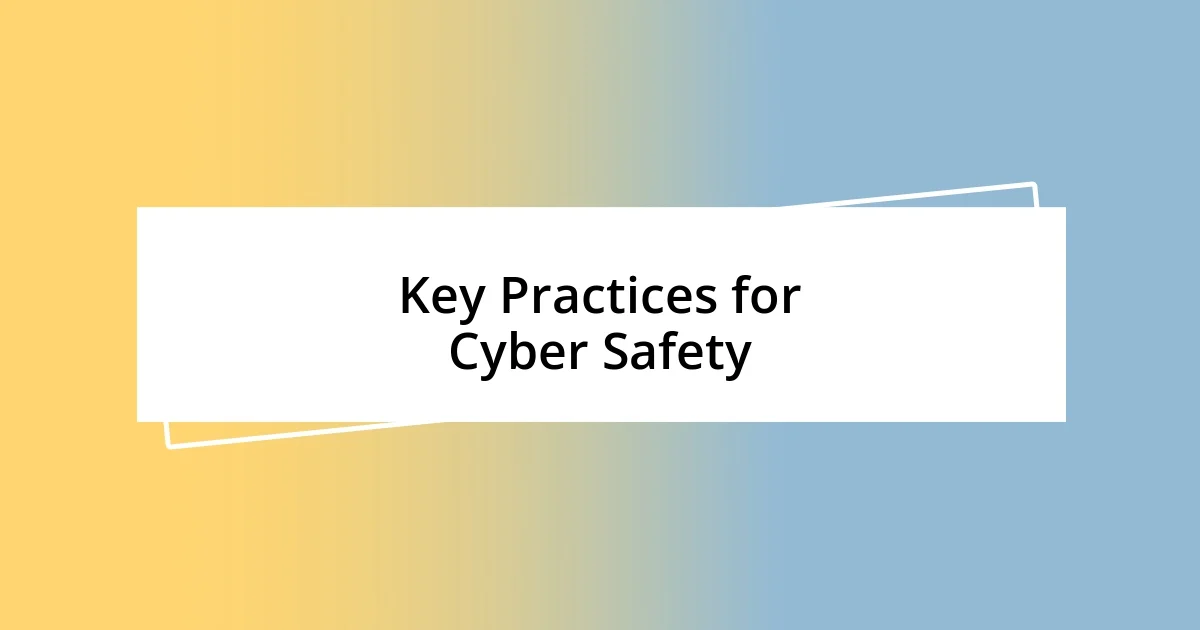
Key Practices for Cyber Safety
When I think about key practices for cyber safety, a few stand out as non-negotiable. For instance, maintaining strong, unique passwords for every account is a fundamental step that I simply can’t stress enough. I remember the time I used a single password for several services, thinking it would make things easier. It ended up causing a nightmare when one site experienced a breach. I felt completely exposed and vulnerable—a feeling I don’t wish on anyone.
Another critical practice is routinely backing up your data. I’ve come to appreciate this lesson after losing vital files due to a ransomware attack on my machine. I could only imagine how much easier it would have been if I’d had a backup. Now, I proactively back up all important files to a secure cloud service. Trust me; it’s a relief to know that if something goes wrong, I won’t lose everything.
Educating myself and others about online threats has also been a game-changer. Sharing knowledge about phishing scams or social engineering tactics helps build a stronger community of cyber-aware individuals. The more we talk about our experiences and learn from each other, the better we can protect ourselves. I often have engaging conversations with friends, where we share the latest cyber threats we’ve encountered, making it feel less daunting and more manageable.
| Practice | Description |
|---|---|
| Password Management | Use unique, complex passwords for each account; change them every 3-6 months. |
| Data Backup | Regularly back up important files to a secure location to prevent data loss. |
| Education and Awareness | Stay informed about the latest cybersecurity threats and share that knowledge. |
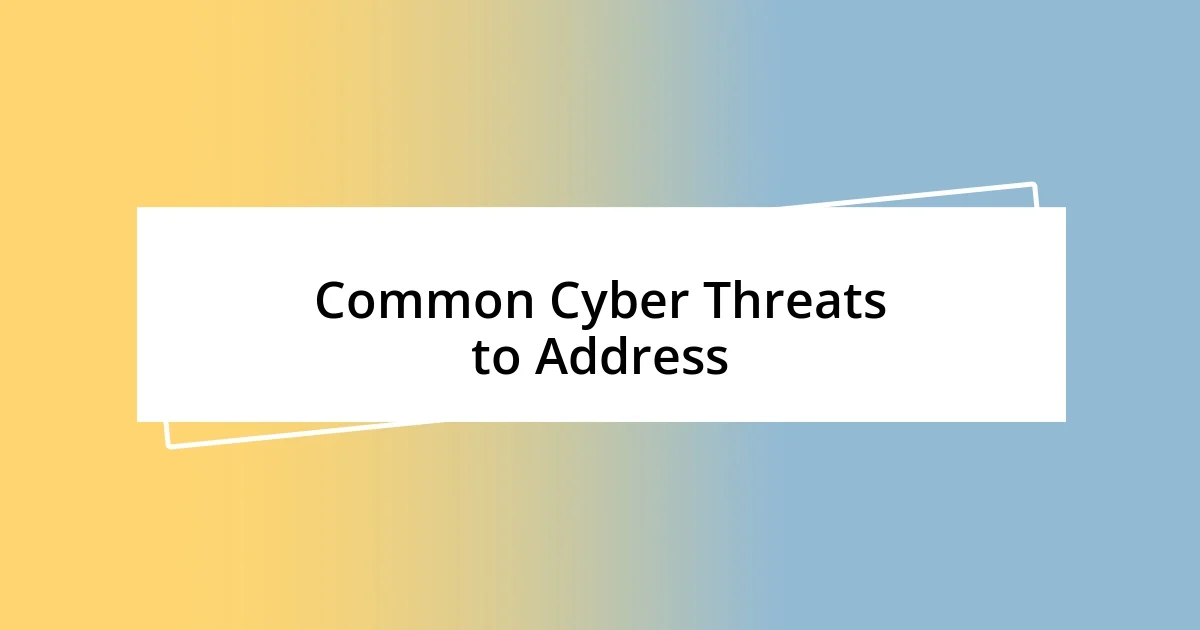
Common Cyber Threats to Address
Common Cyber Threats to Address
One of the most prevalent cyber threats I’ve encountered is phishing attacks. These deceptive emails often appear legitimate, tricking users into revealing sensitive information. I once received an authentic-looking email from a popular service I use, prompting me to “verify” my account details. My heart raced; I was inches away from divulging my login information until I paused to scrutinize the sender’s address. That moment of hesitation saved me from a potential breach.
Another major threat to consider is ransomware. This malicious software locks users out of their files and demands payment for access. I know someone who went through a terrifying ordeal when a ransomware attack crippled their small business. The sheer panic of having crucial client files held hostage was unimaginable! It reinforced for me the importance of regular data backups—it’s a safeguard that every individual or business must adopt.
Finally, I can’t stress enough the dangers of unsecured networks. Using public Wi-Fi feels convenient, but it often comes at a cost. I remember sitting in a café, casually connecting to their free Wi-Fi, unknowingly putting my personal data at risk. A friend had a similar experience, where a hacker intercepted their information right under their nose. Are we really willing to gamble our security for the sake of convenience? Taking a moment to reflect on these risks can lead to better habits and a more secure digital presence.
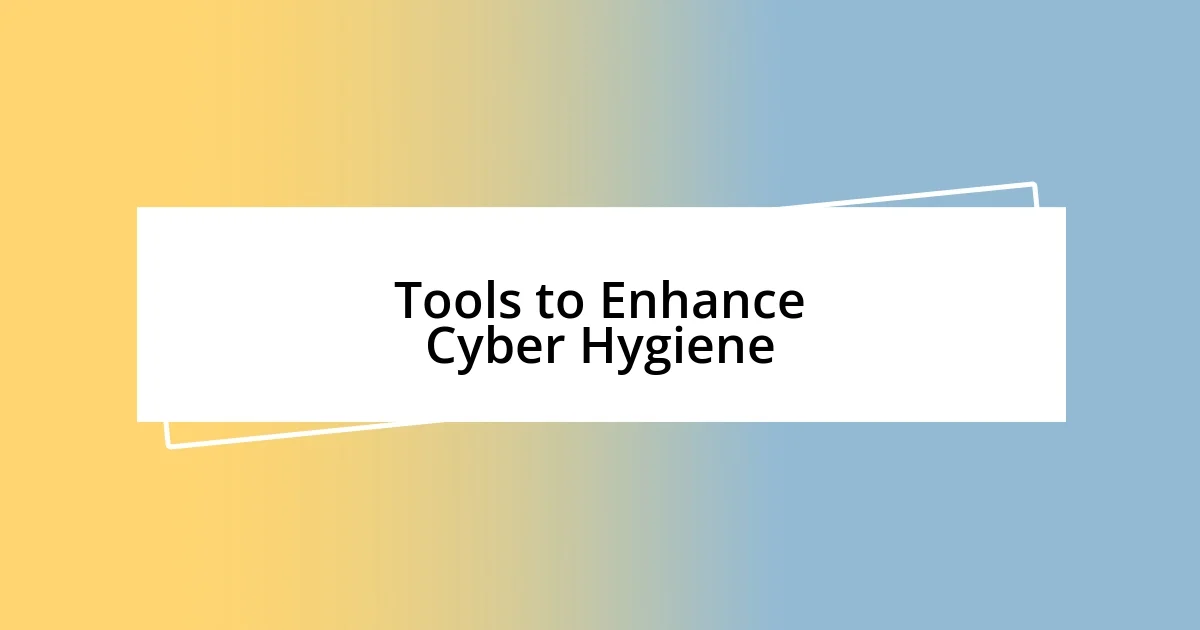
Tools to Enhance Cyber Hygiene
When it comes to tools that enhance cyber hygiene, password managers have truly transformed my online security. I remember when I juggled countless passwords, often resorting to the same few for convenience. It felt chaotic and risky. Now, with a password manager, I create and store complex passwords effortlessly, leaving me feeling secure and organized. Isn’t it empowering to know that all my sensitive data is encrypted and only a single master password stands between me and a myriad of potential threats?
Another tool that has made a noticeable difference is multi-factor authentication (MFA). Incorporating this extra layer into my accounts has drastically improved my peace of mind. I recall one incident where a friend overlooked this and lost access to their email account. The sense of panic they experienced was unsettling. With MFA, I rest assured that even if someone obtains my password, they can’t easily breach my accounts. It’s a simple step, yet it feels like a fortress around my digital life.
Lastly, I’ve found that security software, like antivirus programs and firewalls, significantly bolsters my cyber protection. Initially, I was skeptical about investing in these tools, thinking that my device wouldn’t be targeted. However, I learned that cyber threats lurk everywhere, even on trusted websites. I vividly recall my frustration when a rogue website led to a malware incident on my computer. Since then, I’ve made it a priority to have robust security software running on all my devices. It might feel like an inconvenience at times, but isn’t peace of mind worth a few extra clicks?
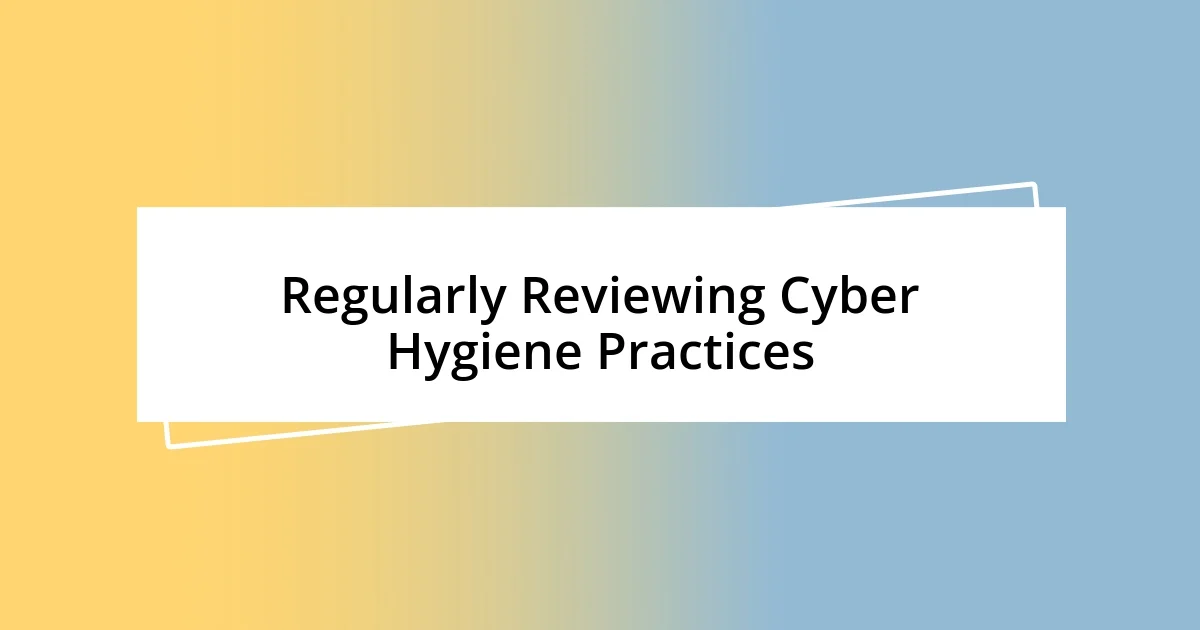
Regularly Reviewing Cyber Hygiene Practices
Regularly reviewing my cyber hygiene practices feels a bit like routine maintenance for my car. Just as I wouldn’t neglect oil changes or tire rotations, I make it a point to assess my digital habits periodically. I remember the feeling of unease when a colleague’s account was hacked despite their claimed diligence. It hit home—taking proactive steps and revisiting those measures ensures I stay one step ahead of potential threats.
I often set aside time each month to scrutinize my password security and account settings. I used to think that once I created strong passwords, I could just forget about them. But a recent surge in data breaches reminded me that vigilance is key. For instance, after learning about a breach at a service I use, I felt an immediate rush of anxiety. Did I use the same password elsewhere? That moment reinforced the importance of not just creating strong passwords, but also reviewing them regularly.
Finally, I’ve adopted a habit of checking for software updates, which has been a game changer. Initially, I found those update reminders annoying, always popping up when I was in the thick of something. But I’ve learned that these updates often include vital security patches. The last time I ignored an update, I found out later that a vulnerability was exposed in the software I was using. The thought of my data being compromised because I clicked “remind me later” sent chills down my spine. Now, I prioritize these updates—they’re a simple yet effective way to bolster my protection. How about you? Are you placing enough emphasis on regular reviews of your cyber hygiene?












